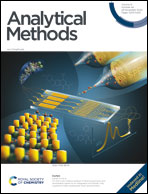A novel hybrid fluorescence probe sensor based on metal–organic framework@carbon quantum dots for the highly selective detection of 6-mercaptopurine†
Abstract
In the present study, MIL-101(Fe) and amine-carbon quantum dots (CQDs) were combined via a post-synthetic modification (PSM) method; thus, a novel MIL-101(Fe)@amine-CQD hybrid fluorescent probe sensor for the detection of 6-mercaptopurine (6-MP) was synthesized. Amine-CQDs as a fluorescent material can convert the bonding interaction between MIL-101(Fe) and 6-MP into recognizable fluorescence signals, and MIL-101 (Fe) as an adsorbent can pre-concentrate 6-MP. Hereupon, this new sensor demonstrates high selectivity and sensitivity towards the detection of 6-MP. The addition of 6-MP to this probe quenches the fluorescence signal at 599 nm. In this study, factors such as pH, response time, and concentration of MIL-101(Fe)@amine-CQDs were optimized by the one-factor-at-a-time (OFAT) method. Under optimal conditions, the relationship between the fluorescence enhancement factor and the concentration of 6-MP for this sensor in the range of 0.1667–1.0000 μg L−1 was linear (R2 = 0.9977, n = 3). The limit of detection and limit of quantitation were 55.70 ng L−1 and 202.06 ng L−1, respectively, which are better than similar techniques. The repeatability of intra-day and inter-day was 2.4% and 4.7%, respectively. This fluorescent sensor was employed to determine 6-MP in real samples and exhibited acceptable results.



 Please wait while we load your content...
Please wait while we load your content...